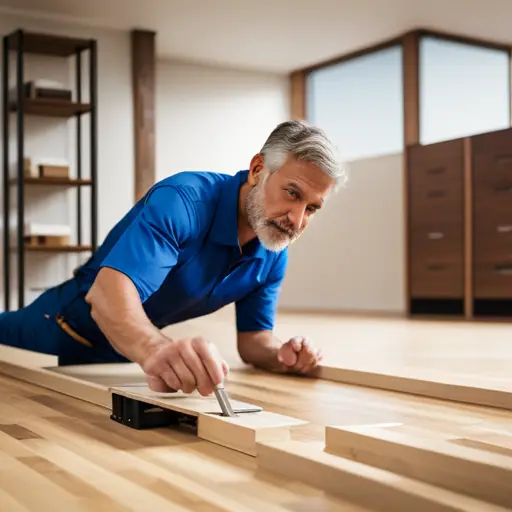Floating Floors: Installation and Benefits

Like a seamless dance across the surface, floating floors offer a practical and visually appealing solution for modern interiors. This article explores the different types, installation process, and the numerous benefits of floating floors.
From the ease of installation to the versatility of design options, readers will gain valuable insights into this popular flooring choice. Whether for residential or commercial spaces, floating floors present a compelling solution for those seeking durability and aesthetic appeal.
Types of Floating Floors
When choosing a floating floor, individuals can consider various types to suit their specific needs and preferences.
Two popular options are laminate and vinyl. Laminate flooring consists of a high-density fiberboard core with a photographic image layer and a clear protective coating. It can mimic the look of hardwood, stone, or tile but is more affordable and easier to install.
On the other hand, vinyl flooring offers a wide range of designs and is known for its water resistance, making it suitable for areas prone to moisture.
Another consideration is between hardwood and engineered floors. Hardwood flooring is made from solid wood and adds a timeless, elegant look to any space. It can be sanded and refinished multiple times, adding to its longevity.
Engineered flooring, however, is constructed with layers of wood and topped with a hardwood veneer. It provides the aesthetic appeal of hardwood while offering greater stability and resistance to moisture and temperature changes.
These different types of floating floors cater to varying preferences and requirements, ensuring that there is a suitable option for every homeowner’s needs. Understanding the distinctions between laminate vs. vinyl and hardwood vs. engineered floors is crucial in making an informed decision when considering a floating floor installation.
Transitioning into the subsequent section about ‘steps for installing floating floors’, it is essential to grasp the specific installation processes for each type of floating floor.
Steps for Installing Floating Floors
Continuing from the discussion of different types of floating floors, the initial step for installing floating floors is to thoroughly clean and prepare the subfloor to ensure a smooth and level surface. Subfloor preparation is crucial for the success of the installation process. Any irregularities in the subfloor can impact the integrity and longevity of the floating floor.
After cleaning the subfloor to remove any dust, debris, or adhesive residues, it is essential to check for moisture levels. Excessive moisture can lead to warping, buckling, and other issues with the floating floor. Therefore, installing a moisture barrier is often necessary to protect the flooring material from moisture seeping up from the subfloor.
Once the subfloor is clean, level, and adequately protected from moisture, the installation of the floating floor can proceed.
Proper subfloor preparation and the installation of moisture barriers are fundamental steps in ensuring the successful installation of floating floors. These steps provide a stable and suitable environment for the floating floor, promoting its longevity and performance.
Tools and Materials Needed for Installation
The tools and materials needed for the installation of floating floors include:
- Tapping block
- Spacers
- Pull bar
- Circular saw
- Underlayment
These flooring tools are essential for ensuring a smooth and professional installation process. The tapping block is used to fit the planks together tightly without causing damage. Spacers help maintain the required expansion gap between the flooring and the walls. A pull bar is necessary for closing the gaps at the edges of the room, ensuring a snug fit. A circular saw is crucial for making precise cuts on the flooring material, especially when dealing with intricate corners and angles. Additionally, underlayment, a vital flooring material, provides cushioning and sound absorption, enhancing the overall performance and longevity of the floating floor.
Understanding and utilizing these flooring tools and materials are fundamental to achieving a successful installation. Their proper use ensures that the floating floor is installed securely and with professional precision, which ultimately impacts the quality and longevity of the flooring.
Now, let’s delve into the benefits of floating floors.
Benefits of Floating Floors
Floating floors offer both insulation against sound and moisture.
One of the key benefits is the cost savings associated with installation. Unlike traditional flooring, floating floors can be installed over existing surfaces, which reduces the need for expensive demolition and disposal of old flooring materials. Additionally, the click-and-lock or adhesive-free installation systems save on labor costs.
Furthermore, floating floors are known for their durability, as they are constructed to withstand heavy foot traffic and resist scratches, stains, and fading.
Another advantage of floating floors is their sound insulation properties. The underlayment beneath the floating floor helps absorb sound, making it an ideal choice for apartments, condominiums, and upper-level rooms.
Moreover, many floating floor materials are eco-friendly, as they are often made from sustainable or recycled materials. This makes them a popular choice for environmentally conscious consumers.
Maintenance and Care for Floating Floors
To maintain and care for floating floors, it is essential to regularly clean and inspect the surface for any signs of wear or damage. Proper maintenance ensures the long-term durability of the flooring.
Here are some cleaning tips and care techniques for floating floors:
-
Regular Cleaning: Use a vacuum or a dry mop to remove dust, dirt, and debris. Avoid using wet mops as excessive moisture can damage the flooring.
-
Avoid Harsh Chemicals: When cleaning the floor, use a mild detergent or specially formulated cleaner recommended by the flooring manufacturer. Harsh chemicals can cause discoloration or damage to the floor’s finish.
-
Protective Pads: Attach felt or rubber pads to the legs of furniture to prevent scratches and dents on the flooring.
-
Immediate Spill Cleanup: Wipe up spills immediately to prevent staining or warping of the floorboards.
-
Preventive Measures: Place doormats at entryways to reduce the amount of dirt and grit that can be tracked onto the floor.
Following these maintenance and care tips will help preserve the appearance and longevity of your floating floors.
Frequently Asked Questions
Can Floating Floors Be Installed Over Existing Carpet?
Yes, floating floors can be installed over existing carpet. However, it is essential to remove the carpet and ensure proper subfloor preparation. Additionally, the installation may require a moisture barrier, especially in bathroom areas.
What Are Some Common Mistakes to Avoid During the Installation of Floating Floors?
When installing floating floors, it’s crucial to avoid mistakes by ensuring proper measurements and thorough floor preparation. Challenges in installation often stem from inadequate prep work. Precision and attention to detail are essential.
Are There Any Specific Subfloor Requirements for Installing Floating Floors?
Subfloor preparation is crucial for installing floating floors. It must be clean, level, and dry. Moisture barrier installation is necessary to prevent moisture from seeping into the floor. Following these requirements ensures a successful installation.
Can Floating Floors Be Installed in Bathrooms or Other High-Moisture Areas?
Floating floors can be installed in bathrooms or high-moisture areas. It’s crucial to ensure the materials are suitable for such environments, using waterproofing methods and choosing flooring options specifically designed to resist moisture.
How Long Do Floating Floors Typically Last Before Needing to Be Replaced?
Floating floors, with proper care, typically last 15-25 years before needing replacement. To extend their lifespan, regular maintenance is essential. Avoiding excessive moisture, using furniture pads, and promptly addressing any damage can help preserve floating floors.
Conclusion
In conclusion, floating floors offer numerous benefits such as easy installation, versatility, and durability.
Maintenance for floating floors is simple, requiring only regular cleaning and occasional resealing.
Like a sturdy ship floating on calm waters, floating floors provide a stable and reliable foundation for any space.

Rubin Everest, a seasoned expert in the world of flooring, brings a wealth of knowledge and passion to the surface. As the mind behind ebbow.com, Rubin is dedicated to sharing insights on the latest trends, innovative solutions, and expert advice in the realm of flooring. Whether you’re seeking practical tips for installation or design inspiration, Rubin Everest is your go-to source for all things flooring-related, making your journey to the perfect floor an informed and enjoyable experience.





